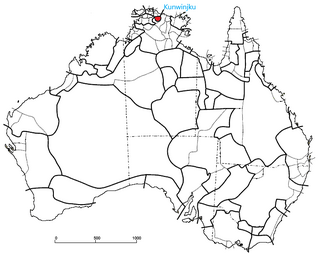
The Kunwinjku people are an Australian Aboriginal people, one of several groups within the Bininj people, who live around West Arnhem Land to the east of Darwin, Northern Territory. Kunwinjku people generally refer to themselves as "Bininj" in much the same way that Yolŋu people refer to themselves as "Yolŋu".

The Ngarigo people are Aboriginal Australian people of southeast New South Wales, whose traditional lands also extend around the present border with Victoria. They are named for their language, Ngarigo, which in the 19th century was said to be spoken by the Nyamudy people.
The Awarai (Warray) are an indigenous Australian people of the Northern Territory.
The Yukul, also written Jukul, were an indigenous Australian people of the Northern Territory.
The Mangarayi, also written Mangarai, were an indigenous Australian people of the Northern Territory.
The Tjial were an indigenous Australian people of the Northern Territory who are now extinct.

The Arabana, also known as the Ngarabana, are an Aboriginal Australian people of South Australia.
The Wangkangurru, also written Wongkanguru and Wangkanguru, are an Aboriginal Australian people of the Simpson Desert area in the state of South Australia. They also refer to themselves as Nharla.
The Wanggamala people, also spelt Wangkamahdla, Wangkamadla, Wangkamanha, Wangkamana, Wonkamala, Wongkamala, Wonkamudla, and other variants, are an Aboriginal Australian people of the Northern Territory and Queensland.
The Ngameni are an indigenous Australian people of South Australia who once spoke the Ngameni language.
The Punthamara were an indigenous Australian people of the state of Queensland.
The Alura are an Aboriginal Australian people of the Northern Territory.
The Andakerebina were an indigenous Australian people of the Northern Territory.
The Wilingura otherwise known as the Wilangarra, were an indigenous Australian people of the Northern Territory.
The Kaiabara are an indigenous Australian people of the state of Queensland.
The Ngundjan (Ogh-Undjan) were an indigenous Australian people of the state of Queensland.

The Luritja or Loritja people, also known as Kukatja or Kukatja-Luritja, are an Aboriginal Australian people of the Northern Territory. Their traditional lands are immediately west of the Derwent River, that forms a frontier with the Arrernte people, with their lands covering some 27,000 square kilometres (10,300 sq mi). Their language is the Luritja dialect, a Western Desert language.
The Gudanji, otherwise known as the Kotandji or Ngandji, are an indigenous Australian people of the Northern Territory.
The Jingili or Jingulu are an indigenous Australian people of the Northern Territory.
The Mariu were an indigenous Australian people of the Northern Territory. Their language is unattested, but may have been Miriwung.